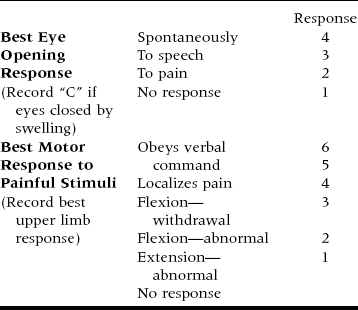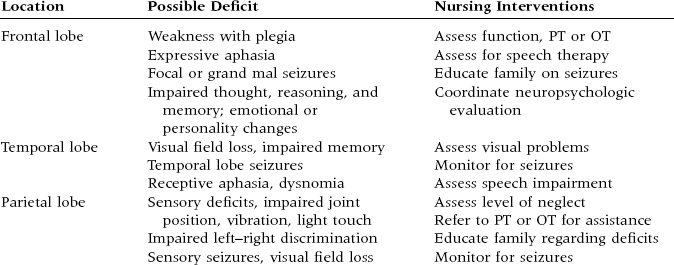Chapter 9 For an in-depth study of the nervous system, consult the following publications: Lewis SM, et al: Medical-surgical nursing, ed 8, St. Louis, 2011, Mosby. Nugent P, Green J, Hellmer Saul MA, Pelikan P: Mosby’s comprehensive review of nursing for the NCLEX-RN examination, ed 20, St. Louis, 2012, Mosby. Patton K, Thibodeau G: Structure and function of the human body, ed 14, St. Louis, 2012, Mosby. Potter PA, Perry AG, Stockert PA, Hall A: Fundamentals of nursing, ed 8, St. Louis, 2013, Mosby. Weilitz P, Potter PA: Pocket guide for health assessment, ed 6, St. Louis, 2007, Mosby. Alert Awake and aware, responds appropriately, begins conversation (A&O × 3: alert and oriented to person, place, time) Lethargic Sleeps but easily aroused, speaks and responds slowly but appropriately Obtunded Difficult to arouse, slow to respond, and returns to sleep quickly Stuporous Aroused only through pain, no verbal response, never fully awake Semicomatose Responds only to pain but has gag and blink reflexes • Numbness of face, arm, or leg • Weakness of face, arm, or leg • Difficult speaking or understanding • Sudden decreased or blurred vision Seizure Abnormal electrical activity in the brain Epilepsy Recurrent unprovoked seizures Generalized tonic-clonic seizure Previously called grand mal. Tonic means stiffening, and clonic means rhythmic shaking. There is abnormal electrical activity affecting the whole brain (thus the term “generalized”). Partial seizure Sometimes confused with petit mal. Only a part of the brain is affected. Simple partial The patient remains alert and is behaving appropriately. Complex partial The person is conscious but impaired. Absence seizure Previously called petit mal. This is a generalized seizure without shaking. Postictal state The period after a generalized or partial seizure during which the person usually feels sleepy or confused. Aura A warning of a seizure. Actually, the aura is an early part of the seizure itself. Febrile seizures Generally occur in infants and young children; they are most often generalized tonic-clonic seizures. They typically occur in children with a high fever, usually higher than 102°F. Status epilepticus (SE) A state of continuous or frequently reoccurring seizures lasting 30 minutes or more. Bed should be in the lowest position. Side rails should be up and padded. Oxygen and suction equipment should be nearby. Indicate “seizure precautions” on plan of care. Note if patient has an aura before seizures. Use digital thermometers, NOT glass thermometers. Patients should shower rather than use a tub. Always transport the patient with portable oxygen. Patients with frequent generalized atonic seizures should wear helmets. Call for help but DO NOT try to restrain the person. Help the person to lie down. Place something soft under the head. Turn the person on his or her side if possible. Remove glasses and loosen tight clothing. DO NOT place anything between the teeth. DO NOT attempt to remove dentures. Monitor the duration of the seizure and the type of movement. Turn the person to one side to allow saliva to drain; suction if needed. Perform vital signs and neurologic checks as needed. DO NOT offer food or drink until the person is fully awake. Notify physician unless the person is being monitored specifically for seizures. Notify physician immediately if seizure occurs without regaining consciousness or if an injury occurs. Document the time and length of the seizure and if there was an aura. Document the sequence of behaviors during the seizures (e.g., eye movement). Document an injury and what was done about it. Note what happened with the person just after the seizure (did he or she reorient?). • Have the patient describe his or her specific problem. • Have the patient describe his or her symptoms and alleviating factors. • Assess the patient’s normal sleep pattern. • Assess the patient’s normal bedtime rituals. • Assess for current or recent physical illnesses. • Assess for current or recent emotional stress. • Assess for possible sleep disorders. • Assess the patient’s current medications and their possible effects on sleep. Bruxism Tooth grinding during sleep Insomnia Chronic difficulty with sleep patterns
Nervous System
Levels of Consciousness
Warning Signs of Impending Stroke
Seizure Terminology
Care of the Patient with Seizures
During the Seizure
After the Seizure
A Patient’s Sleep History
Sleep Disorders
< div class='tao-gold-member'>
![]()
Stay updated, free articles. Join our Telegram channel

Full access? Get Clinical Tree


Nervous System
Only gold members can continue reading. Log In or Register to continue




